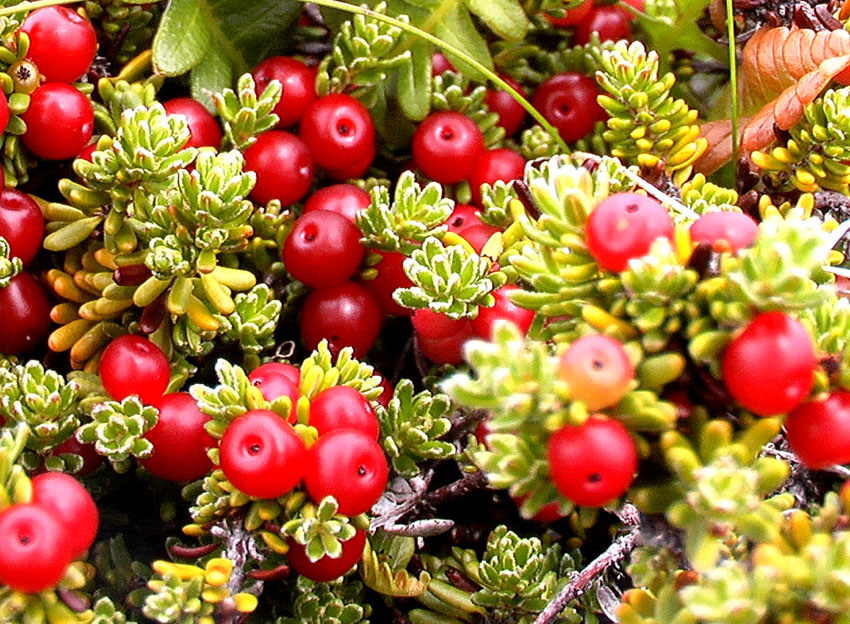
|
Family: Ericaceae |
Shrubs. Stems prostrate, trailing, (densely branched, 0.5-1 m, woody); branchlets glabrous or sparsely to densely hairy or glandular distally. Leaves persistent, whorled or spirally arranged; petiole present, (very short); blade (lustrous or opaque, linear, oblong, or elliptic), coriaceous, margins entire, (strongly revolute, enclosing abaxial surface and forming waxy stomatal cavity appearing as groove, surfaces glabrous, glandular, or hairy). Inflorescences solitary flowers (borne on short shoots from axils of distal leaves); perulae absent. Flowers unisexual or bisexual (plants synoecious, sometimes polygamous, or dioecious), radially symmetric; sepals 3, distinct, (oblong); petals 3, (white), corolla deciduous (hence reports of apetalous flowers), oblanceoloid; stamens (2-)4(-6) (staminate flowers usually with 3 stamens), exserted; anthers without awns, dehiscent from slits; ovary 6-9-locular; style exserted; stigma branched. Fruits drupaceous, globose, fleshy, enclosed by nonfleshy calyx. Seeds 6-9, ovoid, not winged, not tailed; testa smooth or with minute spicules. x = 13. Comprehensive taxonomies of Empetrum are relatively few and none is recent (e.g., R. Good 1927; V. N. Vassiljev 1961). Empetrum in North America has been treated regionally, especially in northeastern North America, without consideration of the problems faced continent-wide, and without a unified taxonomy that addresses the variation elsewhere. In his circumpolar review, E. Hultén (1971) wrote of Empetrum: 'A...complex, where different authors rarely, if ever, arrive at the same conclusion.' He remarked that the genus Empetrum could be considered to comprise a single, variable species. Vassiljev, on the other hand, proposed 18 species worldwide, ten for North America including Greenland. Empetrum is monophyletic (A. A. Anderberg 1994c; Li J. H. et al. 2002; M. Popp et al., unpubl.). Analyses of morphology (Anderberg) and molecular genetics (Li et al.; Popp et al.) have shown relationships to other closely related ericads, congeners, and to some extent within Empetrum. Using molecular methods, V. Mirré (2004) using amplified fragment length polymorphism (AFLP) and Popp et al. using plastid trnS-trnfM and trnS-trnG and nuclear RPB2 and RPC2 sequences have, in preliminary studies, evaluated relationships among taxa, but without finding sufficient structure to create a new taxonomy. However, these studies tell us that assumptions about key characters in the treatment by V. N. Vassiljev (1961), for example, are not well supported by molecular data, and we cannot, therefore, simply accept and repeat entirely what is in previous, albeit monographic, treatments. A. A. Anderberg (1994c) and V. Mirré (2004) found good separation of the red-fruited Southern Hemisphere plants (Empetrum rubrum Vahl ex Willdenow), although Li J. H. et al. (2002) and M. Popp et al. (unpubl.) did not. Nevertheless, we are treating E. rubrum as distinct from all North American taxa. Popp et al. did find that red-fruited, diploid E. eamesii was well separated from other taxa in the region, whereas, in terms of molecular genetics, the Southern Hemisphere red-fruited diploid E. rubrum has its closest connections in the Northern Hemisphere not to E. eamesii but to black-fruited Northern Hemisphere plants treated here as E. nigrum in the broad sense. The solution is to recognize the diploid E. eamesii, the diploid and tetraploid E. nigrum, and E. atropurpureum as a possible allotetraploid from diploid E. eamesii and a diploid E. nigrum. This leaves a great deal of variation within E. nigrum in the broad sense unaccounted for. Various hybrid combinations were alleged by D. Löve (1960); these require confirmation. For the most part, as there are exceptions, diploid taxa are normally dioecious and tetraploids are normally synoecious but sometimes polygamous.* * The authors kindly wish to acknowledge the unpublished information provided by John Maunder, Pierre Morrisett, and Peter Zika on the northeastern endemic taxa of Empetrum for the flora area.
Fls unisexual or (ours) often perfect; sep, pet, and stamens each 4; filaments elongate; ovary depressed-globose, 6-9-locular; style very short, with 6-9 expanded, spreading, toothed or lobed stigmas; fr a drupe with 6-9 stones, the style persistent; dwarf, much-branched shrubs with greenish or purplish fls subsessile in the axils; x=13. 2, mainly cool N. Hemisphere. Gleason, Henry A. & Cronquist, Arthur J. 1991. Manual of vascular plants of northeastern United States and adjacent Canada. lxxv + 910 pp. ©The New York Botanical Garden. All rights reserved. Used by permission. |



